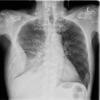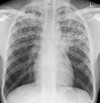Week 4 Flashcards
(63 cards)
What are the 4 functions of the complement system?
- Pathogen killing (mediated by MAC)
- Pathogen opsonisation and phagocytosis (mediated by C3b)
- Mast cell degranulation (mediated by C3a and C5a)
- Immune complex solubilisation
What is the difference between immunisation and vaccination?
Immunisation - process by which an individual develops memory/immunity to a disease
Vaccination - deliberate administration of antigenic material to induce immunity
How does empyema develop? What is the mortality rate?
57% of all patients with pneumonia will develop some pleural fluid.
Starts as a simple parapneumonic effusion
- clear fluid
- pH > 7.2
- LDL < 1000
- glucose >2.2
Becomes a complicated parapneumonic effusion
- pH < 7.2
- LDL > 1000
- glucose <2.2
- Requires chest drain
Progresses to empyema
- Frank pus present
- Mortality rate is 20%
What type of Hypersensitivity is associated with TB? What is classically seen?
Type IV (delayed hypersensitivity)
Granuloma formation with necrosis (caseating)
Opportunistic pathogen associated with patients with AIDS/immunosuppression?
Treatment?
Pneumocystis jirovecii pneumonia (PCP)
Treatment - Co-trimoxazole (+/- prophylaxis)
Describe the immunoglobulin profiles in primary vs secondary infection
Primary - IgM initially, followed by a slower rise in IgG
Secondary - Same IgM response, but much larger IgG response at the same time

Bronchiectasis - clinical signs and symptoms
Productive cough with green/yellow sputum
Occasionally may present with haemoptysis
Frequent bronchial infections, breathlessness
Bad breath (possibly indicating infection)
Crepitations may be heard on auscultation
What bacteria commonly colonise the upper respiratory tract? Gram +ve and Gram -ve examples
Gram +ve
- Strep pneumoniae (alpha haemolytic)
- Strep pyogenes (beta haemolytic)
- Staph aureus
Gram -ve
- Haemophilus influenzae
- Moraxella catharalis
- many more
What is the causative organism of Whooping cough?
What is the treatment? What if the patient is pregnant?
Bordetella pertussis, gram negative coccobacillus
If the cough has been present for more than 3 weeks, Clarithromycin (Erythromycin if pregnant)
What are some conditions that could result in Bronchiectasis?
CF
Bronchial obstruction
Young’s syndrome, Kartagener’s syndrome
Immunodeficiency
Rheumatoid arthritis
Idiopathic in >50% of cases
What are the most common causative organisms of TB?
Mycobacterium tuberculosis and Mycobacterium bovis
What are some important points to bear in mind when using Rifampicin?
It colours all bodily fluids orange
Prompts rapid breakdown of all steroid molecules, including hormonal contraception
Scenario - middle-aged woman has had a persistent cough, has had frequent chest infections throughout our life and is on numerous antibiotics.
Diagnosis?
CF or Bronchiectasis.
Oh, and she mentions her sister has CF… follow with genetic testing looking for common CF gene mutations (F508del, G551D)
Secondary TB is reinfection/reactivation of latent disease. When this occurs, how does the infection typically present (location)?
Typically remains localised, often in the apices of the lungs. Can spread however via the airways or blood stream.
Chronic Bronchial Sepsis - clinical presentation
All the hallmarks of bronchiectasis but no appearance on CT
Often younger patients, mainly women, often involved in childcare
Others are older, with COPD/airway disease
Primary immunodeficines are more common than secondary, true or false?
False
Primary are rare, affectin 1:10,000 live births
Secondary are often subtle and involve more than one component of the immune system
Empyema - diagonsis
CXR - don’t forget lateral!
Ultrasound sonography - preferred investigation, simple bedside testing
CT - differentiate between empyema and abscess
(note D sign on CXR)

What are the potential negative effects of tuberculosis treatment?
Both Rifampicin and Isoniazid are associated with liver dysfunction (more frequently in women)
Steroid use can also lead to the reactivation of latent TB
Phagocytic cells (e.g. neutrophils and macrophages) are particularly important in defence against…
Bacteria and fungi
How do vaccines work?
Generate a memory B and T cell response in 14-21 days.
Most of these cells will die off via apoptosis in the absence of pathogen, but a small number will become memory cells
What is Leukocyte Adhesion Deficiency (LAD)?
Rare primary immunodeficiency, defect in leucocyte integrins (CD18)
Failure in neutrophil adhesion and migration
Characterised by leukocytosis (raised WBCs) and localised bacterial infections
Intra-pulmonary abscess - clinical signs
Lethargy, tiredness, weakness
Weight loss is common
Cough +/- sputum
High mortality if left untreated
Usually there is a preceding illness i.e. pneumonia, aspiration/foreign body, post-virus
(note fluid level in picture)

How does Kostmann syndrome present?
Infections - usually within 2 weeks of birth
Fever, irritability, oral ulceration, failure to thrive
Briefly outline the idea behind memory B and T cell reactivation
Resting cells become activated
Clonal expansion occurs
Cells differentiate into Effector or Memory cells










